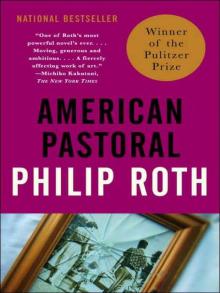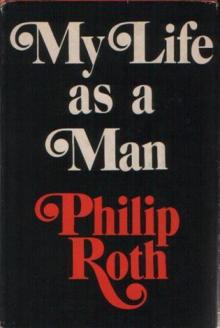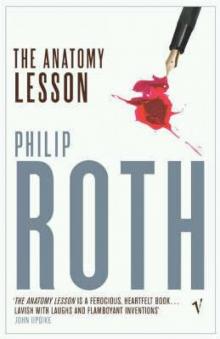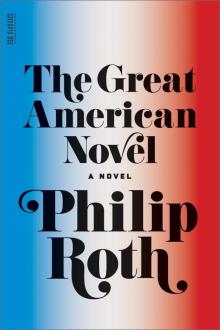- Home
- Philip Roth
American Pastoral
American Pastoral Read online
American Pastoral
Philip Roth
VINTAGE INTERNATIONAL
Vintage Books
A Division of Random House, Inc. New York
To J. G.
FIRST VINTAGE INTERNATIONAL EDITION, FEBRUARY 1998 Copyright © 1997 by Philip
Roth
All rights reserved under International and Pan-American Copyright Conventions.
Published in the United States by Vintage
Books, a division of Random House, Inc., New York, and
simultaneously in Canada by Random House of Canada Limited,
Toronto. Originally published in hardcover in the United States by
Houghton Mifflin Company, New York, in 1997.
“Dream” by Johnny Mercer. Copyright 1944 (renewed),
WB Music Corp. All rights reserved. Used by permission.
Warner Bros. Publications U.S. Inc.,
Miami, Florida, 33014.
Library of Congress Cataloging-in-Publication Data
Roth, Philip. American pastoral / Philip Roth.—1st Vintage International ed.
p. cm.
ISBN 0-375-70142-7
1. United States—History—1961-1969—Fiction. I. Title.
PS3568.0855A77 1998 97-35623
813’.54—dc21 CIP
Random House Web address: http://www.randomhouse.com/
Printed in the United States of America 3579B864
Dream when the day is thru, Dream and they might come true, Things never are as
bad as they seem, So dream, dream, dream.
— Johnny Mercer,
from “Dream” popular song of the 1940$
the rare occurrence of the expected …
— William Carlos Williams, from “At Kenneth Burke’s Place,” 1946
I
Paradise Remembered
The Swede. During the war years, when I was still a grade school boy, this was a
magical name in our Newark neighborhood, even to adults just a generation
removed from the city’s old Prince Street ghetto and not yet so flawlessly
Americanized as to be bowled over by the prowess of a high school athlete. The
name was magical; so was the anomalous face. Of the few fair-complexioned Jewish
students in our preponderantly Jewish public high school, none possessed
anything remotely like the steep-jawed, insentient Viking mask of this blue-eyed
blond born into our tribe as Seymour Irving Levov.
* * *
The Swede starred as end in football, center in basketball, and first baseman in
baseball. Only the basketball team was ever any good—twice winning the city
championship while he was its leading scorer—but as long as the Swede excelled,
the fate of our sports teams didn’t matter much to a student body whose elders,
largely undereducated and overburdened, venerated academic achievement above all
else. Physical aggression, even camouflaged by athletic uniforms and official
rules and intended to do no harm to Jews, was not a traditional source of
pleasure in our community— advanced degrees were. Nonetheless, through the
Swede, the neighborhood entered into a fantasy about itself and about the world,
the fantasy of sports fans everywhere: almost like Gentiles (as they
AMERICAN PASTORAL
imagined Gentiles), our families could forget the way things actually work and
make an athletic performance the repository of all their hopes. Primarily, they
could forget the war.
The elevation of Swede Levov into the household Apollo of the Weequahic Jews can
best be explained, I think, by the war against the Germans and the Japanese and
the fears that it fostered. With the Swede indomitable on the playing field, the
meaningless surface of life provided a bizarre, delusionary kind of sustenance,
the happy release into a Swedian innocence, for those who lived in dread of
never seeing their sons or their brothers or their husbands again.
And how did this affect him—the glorification, the sanctifica-tion, of every
hook shot he sank, every pass he leaped up and caught, every line drive he
rifled for a double down the left-field line? Is this what made him that staid
and stone-faced boy? Or was the mature-seeming sobriety the outward
manifestation of an arduous inward struggle to keep in check the narcissism that
an entire community was ladling with love? The high school cheerleaders had a
cheer for the Swede. Unlike the other cheers, meant to inspire the whole team or
to galvanize the spectators, this was a rhythmic, foot-stomping tribute to the
Swede alone, enthusiasm for his perfection undiluted and unabashed. The cheer
rocked the gym at basketball games every time he took a rebound or scored a
point, swept through our side of City Stadium at football games any time he
gained a yard or intercepted a pass. Even at the sparsely attended home baseball
games up at Irvington Park, where there was no cheerleading squad eagerly
kneeling at the sidelines, you could hear it thinly chanted by the handful of
Weequahic stalwarts in the wooden stands not only when the Swede came up to bat
but when he made no more than a routine putout at first base. It was a cheer
that consisted of eight syllables, three of them his name, and it went, Bah bah-
bah! Bah bah bah … bah-fraW and the tempo, at football games particularly,
accelerated with each repetition until, at the peak of frenzied adoration, an
explosion of skirt-billowing cartwheels was ecstatically discharged and the
orange gym bloom-
ers of ten sturdy little cheerleaders flickered like fireworks before our
marveling eyes … and not for love of you or me but of the wonderful Swede.
“Swede Levov! It rhymes with … ‘The Love’!… Swede Levov! It rhymes with . .
. ‘The Love’! … Swede Levov! It rhymes with … ‘The Love’!”
Yes, everywhere he looked, people were in love with him. The candy store owners
we boys pestered called the rest of us “Hey-you-no!” or “Kid-cut-it-out!”; him
they called, respectfully, “Swede.” Parents smiled and benignly addressed him as
“Seymour.” The chattering girls he passed on the street would ostentatiously
swoon, and the bravest would holler after him, “Come back, come back, Levov of
my life!” And he let it happen, walked about the neighborhood in possession of
all that love, looking as though he didn’t feel a thing. Contrary to whatever
daydreams the rest of us may have had about the enhancing effect on ourselves of
total, uncritical, idolatrous adulation, the love thrust upon the Swede seemed
actually to deprive him of feeling. In this boy embraced as a symbol of hope by
* * *
so many—as the embodiment of the strength, the resolve, the emboldened valor
that would prevail to return our high school’s servicemen home unscathed from
Midway, Salerno, Cherbourg, the Solomons, the Aleutians, Tarawa—there appeared
to be not a drop of wit or irony to interfere with his golden gift for
responsibility.
But wit or irony is like a hitch in his swing for a kid like the Swede, irony
being a human consolation and beside the point if you’re getting your way as a
god. Either there was a whole si
de to his personality that he was suppressing or
that was as yet asleep or, more likely, there wasn’t. His aloofness, his seeming
passivity as the desired object of all this asexual lovemaking, made him appear,
if not divine, a distinguished cut above the more primordial humanity of just
about everybody else at the school. He was fettered to history, an instrument of
history, esteemed with a passion that might never have been if he’d broken the
Weequahic basketball record—by scoring twenty-seven points against Barringer—on
a day other than the sad, sad day in 1943 when fifty-eight Flying
AMERICAN PASTORAL
Fortresses were shot down by Luftwaffe fighter planes, two fell victim to flak,
and five more crashed after crossing the English coast on their way back from
bombing Germany.
The Swede’s younger brother was my classmate, Jerry Levov, a scrawny, small-
headed, oddly overflexible boy built along the lines of a licorice stick,
something of a mathematical wizard, and the January 1950 valedictorian. Though
Jerry never really had a friendship with anyone, in his imperious, irascible
way, he took an interest in me over the years, and that was how I wound up, from
the age of ten, regularly getting beaten by him at Ping-Pong in the finished
basement of the Levovs’ one-family house, on the corner of Wynd-moor and Keer—
the word “finished” indicating that it was paneled in knotty pine, domesticated,
and not, as Jerry seemed to think, that the basement was the perfect place for
finishing off another kid.
The explosiveness of Jerry’s aggression at a Ping-Pong table exceeded his
brother’s in any sport. A Ping-Pong ball is, brilliantly, sized and shaped so
that it cannot take out your eye. I would not otherwise have played in Jerry
Levov’s basement. If it weren’t for the opportunity to tell people that I knew
my way around Swede Levov’s house, nobody could have got me down into that
basement, defenseless but for a small wooden paddle. Nothing that weighs as
little as a Ping-Pong ball can be lethal, yet when Jerry whacked that thing
murder couldn’t have been far from his mind. It never occurred to me that this
violent display might have something to do with what it was like for him to be
the kid brother of Swede Levov. Since I couldn’t imagine anything better than
being the Swede’s brother—short of being the Swede himself—I failed to
understand that for Jerry it might be difficult to imagine anything worse.
The Swede’s bedroom—which I never dared enter but would pause to gaze into when
I used the toilet outside Jerry’s room—was tucked under the eaves at the back of
the house. With its slanted ceiling and dormer windows and Weequahic pennants on
the walls, it looked like what I thought of as a real boy’s room. From the two
windows that opened out over the back lawn you could see the roof
of the Levovs’ garage, where the Swede as a grade school kid practiced hitting
in the wintertime by swinging at a baseball taped to a cord hung from a rafter—
an idea he might have got from a baseball novel by John R. Tunis called The Kid
from Tomkinsville. I came to that book and to other of Tunis’s baseball books—
Iron Duke, The Duke Decides, Champion’s Choice, Keystone Kids, Rookie of the
Year—by spotting them on the built-in shelf beside the Swede’s bed, all lined up
alphabetically between two solid bronze bookends that had been a bar mitzvah
gift, miniaturized replicas of Rodin’s “The Thinker.” Immediately I went to the
* * *
library to borrow all the Tunis books I could find and started with The Kid from
Tomkinsville, a grim, gripping book to a boy, simply written, stiff in places
but direct and dignified, about the Kid, Roy Tucker, a clean-cut young pitcher
from the rural Connecticut hills whose father dies when he is four and whose
mother dies when he is sixteen and who helps his grandmother make ends meet by
working the family farm during the day and working at night in town at
“MacKenzie’s drugstore on the corner of South Main.”
The book, published in 1940, had black-and-white drawings that, with just a
little expressionistic distortion and just enough anatomical skill, cannily
pictorialize the hardness of the Kid’s life, back before the game of baseball
was illuminated with a million statistics, back when it was about the mysteries
of earthly fate, when major leaguers looked less like big healthy kids and more
like lean and hungry workingmen. The drawings seemed conceived out of the dark
austerities of Depression America. Every ten pages or so, to succinctly depict a
dramatic physical moment in the story—”He was able to put a little steam in it,”
“It was over the fence,” “Razzle limped to the dugout”—there is a blackish, ink-
heavy rendering of a scrawny, shadow-faced ballplayer starkly silhouetted on a
blank page, isolated, like the world’s most lonesome soul, from both nature and
man, or set in a stippled simulation of ballpark grass, dragging beneath him the
skinny statuette of a wormlike shadow. He is unglamorous even in a baseball
uniform; if he is the pitcher, his gloved hand looks like a paw; and what image
after image
AMERICAN PASTORAL
makes graphically clear is that playing up in the majors, heroic though it may
seem, is yet another form of backbreaking, unremu-nerative labor.
The Kid from Tomkinsville could as well have been called The Lamb from
Tomkinsville, even The Lamb from Tomkinsville Led to the Slaughter. In the Kid’s
career as the spark-plug newcomer to a last-place Brooklyn Dodger club, each
triumph is rewarded with a punishing disappointment or a crushing accident. The
staunch attachment that develops between the lonely, homesick Kid and the
Dodgers’ veteran catcher, Dave Leonard, who successfully teaches him the ways of
the big leagues and who, “with his steady brown eyes behind the plate,”
shepherds him through a no-hitter, comes brutally undone six weeks into the
season, when the old-timer is dropped overnight from the club’s roster. “Here
was a speed they didn’t often mention in baseball: the speed with which a player
rises—and goes down.” Then, after the Kid wins his fifteenth consecutive game—a
rookie record that no pitcher in either league has ever exceeded—he’s
accidentally knocked off his feet in the shower by boisterous teammates who are
horsing around after the great victory, and the elbow injury sustained in the
fall leaves him unable ever to pitch again. He rides the bench for the rest of
the year, pinch-hitting because of his strength at the plate, and then, over the
snowy winter—back home in Connecticut spending days on the farm and evenings at
the drugstore, well known now but really Grandma’s boy all over again—he works
diligently by himself on Dave Leonard’s directive to keep his swing level (“A
tendency to keep his right shoulder down, to swing up, was his worst fault”),
suspending a ball from a string out in the barn and whacking at it on cold
winter mornings with “his beloved bat” until he has worked himself into a sweat.
“‘Crack…’ The clean sweet sound of a bat squarely meeting a ball.” By the next
season he is ready to return to the Dodgers as a speedy right fielder, bats .325
in the second spot, and leads his team down to the wire as a contender. On the
last day of the season, in a game against the Giants, who are in first place by
only half a game, the Kid kindles the Dodgers’
hitting attack, and in the bottom of the fourteenth—with two down, two men on,
and the Dodgers ahead on a run scored by the Kid with his audacious,
characteristically muscular baserunning— he makes the final game-saving play, a
running catch smack up against the right center-field wall. That tremendous
* * *
daredevil feat sends the Dodgers into the World Series and leaves him “writhing
in agony on the green turf of deep right center.” Tunis concludes like this:
“Dusk descended upon a mass of players, on a huge crowd pouring onto the field,
on a couple of men carrying an inert form through the mob on a stretcher… .
There was a clap of thunder. Rain descended upon the Polo Grounds.” Descended,
descended, a clap of thunder, and thus ends the boys’ Book of Job.
I was ten and I had never read anything like it. The cruelty of life. The
injustice of it. I could not believe it. The reprehensible member of the Dodgers
is Razzle Nugent, a great pitcher but a drunk and a hothead, a violent bully
fiercely jealous of the Kid. And yet it is not Razzle carried off “inert” on a
stretcher but the best of them all, the farm orphan called the Kid, modest,
serious, chaste, loyal, naive, undiscourageable, hard-working, soft-spoken,
courageous, a brilliant athlete, a beautiful, austere boy. Needless to say, I
thought of the Swede and the Kid as one and wondered how the Swede could bear to
read this book that had left me near tears and unable to sleep. Had I had the

 American Pastoral
American Pastoral The plot against America
The plot against America The Human Stain
The Human Stain Nemesis n-4
Nemesis n-4 Sabbath’s Theater
Sabbath’s Theater The Professor of Desire
The Professor of Desire Our Gang
Our Gang The Breast
The Breast Operation Shylock
Operation Shylock The Dying Animal
The Dying Animal Letting Go
Letting Go The Counterlife
The Counterlife Everyman
Everyman Nemesis
Nemesis Exit Ghost
Exit Ghost Portnoy's Complaint
Portnoy's Complaint My Life as a Man
My Life as a Man I Married a Communist
I Married a Communist The Anatomy Lesson
The Anatomy Lesson The Great American Novel
The Great American Novel Shop Talk
Shop Talk The Humbling
The Humbling Zuckerman Unbound
Zuckerman Unbound When She Was Good
When She Was Good The Prague Orgy
The Prague Orgy American Pastoral (Nathan Zuckerman)
American Pastoral (Nathan Zuckerman) Goodbye, Columbus
Goodbye, Columbus Reading Myself and Others
Reading Myself and Others